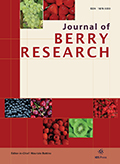Authors: Kamiloglu, Senem | Serali, Ozge | Unal, Nihan | Capanoglu, Esra
Article Type:
Research Article
Abstract:
BACKGROUND: Today, due to its nutritive value, black mulberry (Morus nigra L.) is consumed both as fresh and in processed forms. OBJECTIVE: In order to investigate the health-related constituents of black mulberry products, total phenolics, flavonoids, anthocyanins, antioxidant capacity and major phenolic compounds were determined for different products including fresh mulberry, dried mulberry, mulberry wine, molasses, ice cream, juice, jam and syrup. METHODS: Samples were obtained as three replicates, and total phenolics, flavonoids, anthocyanins, antioxidant capacity were determined by spectrophotometric methods, whereas major phenolic compounds were detected using high-performance liquid chromatography (HPLC) coupled with a photodiode array (PDA) detector. RESULTS:
…In analyzed samples, chlorogenic acid, rutin and cyanidin-3-O-glucoside were confirmed as the major phenolic acid, flavonol and anthocyanin, respectively. In general, fresh mulberry showed higher contents of total phenolics (0.49–57 fold higher), flavonoids (0.02–162 fold higher), anthocyanins (6-12209 fold higher) and antioxidant capacity (0.72–691 fold higher) compared to other products. Total flavonoids and phenolics showed a linear relationship with antioxidant capacity (CUPRAC: R2 = 0.9070 and R2 = 0.8959, respectively), indicating that flavonoids and phenolics were the major contributors to the antioxidant capacity. CONCLUSIONS: These results provide valuable insights into the biochemical composition of black mulberry and how this may change during fruit processing.
Show more
Keywords: Black mulberry (Morus nigra L.), phenolic, flavonoid, anthocyanin, antioxidant, HPLC
DOI: 10.3233/JBR-130045
Citation: Journal of Berry Research,
vol. 3, no. 1, pp. 41-51, 2013




